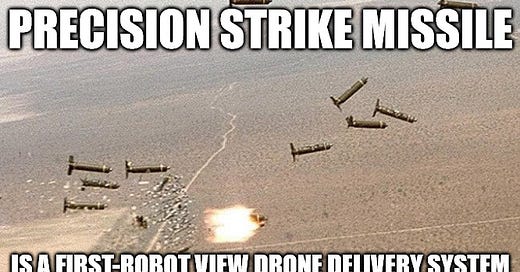The Circle of Strike
The continuity of cluster bombs, FPV suicide drones, and clustered FVP "drones"
As the First-Person View (FPV) suicide drone captures the imagination of so many observers, the Army is seeking robotic versions. Call them First-Robot View (FRV) suicide drones if that feels more trendy.
This article calls for the military to embrace and adapt to small drones:
We urge the militaries of the United States and other democratic states to prepare to both counter drones and harness them during future conflict.
I’ve been on countering small drones for a long time. I argued in Army magazine that the Army needs to control what I called the “brown skies” just over forward combat units because of the threat of swarming drones. I called for fighter drones.
But I digress from my main point of offensive small drones that “big Army” is supposedly ill-equipped to accept.
In that light, this payload for the future Precision Strike Missile is interesting:
“We’re looking for some type of guided submunition deployed from the PrSM form factor and then can seek out targets—tanks, light-skinned vehicles, air defense systems and then target that and destroy it,” he says.
It is not yet clear what companies Lozano referred to. Textron Defense makes the Air Force’s CBU-97 Sensor Fuzed Weapon, which when paired with the Wind Corrected Munitions Dispenser makes the CBU-105. The munition includes a dispenser with 10 submunitions, outfitted with sensor-fused projectiles that seek out targets.
Not that homing submunitions are new. Activists hate them. Cluster bombs bad. America caught some grief when we shipped them off to Ukraine for repelling Russia’s invasion. The West didn’t have enough other artillery ammunition, so the “bad” shells served in a good cause.
As all weapons should do, really.
But the CBU-97 capability can be looked at in light of recent war experience in Ukraine that has made some think the FPV drone is a silver bullet weapon. Before counter-measures—both equipment and tactics—are developed, these drones are carrying the fighting load for Ukraine. But that out-sized role is also affected by artillery shortages and shortages of armored vehicles and troops.
With other weapons available and drone countermeasures fielded, FPV drones will eventually just be one more weapon.
Heck, "peace" activists may point to unexploded FPV suicide drones littering a battlefield and call for a global ban on their use.
I think of those seeking-submunitions as very small robotic FPV drones. They don't require the training and experience of human operators:
A major limitation to the expansion of UAV operations is the need for trained UAV operators. These operators need over a hundred hours of training before they are able to effectively operate these UAVs, and another hundred hours of actual use before they are able to make the most out of the system.
Should the Army really jump on the bandwagon of small, cheap suicide FPV drones when it has CBU-97-type weapons?
Really, this development follows the path of anti-tank guided missiles if you think of FPV drones as modern Sagger ATGMs. CBU-97s are just suicide drones carried to the battlefield in a dispenser shell, but with no loiter time. It's a First-Robot View suicide drone, no?
Ah, the circle of life death.




